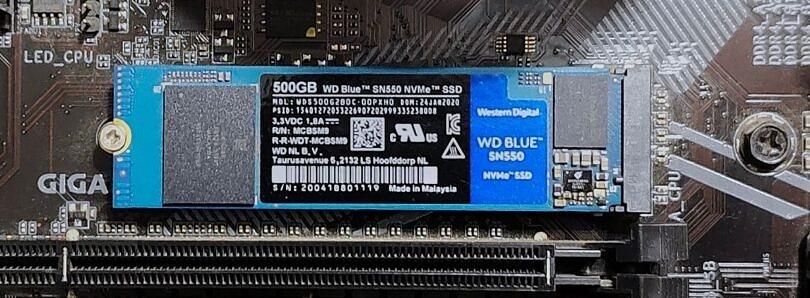Adding an SSD is the best upgrade for an old PC to improve its performance
The last couple of years have been rough for those trying to get parts for a new PC build. It’s been well over a year since the global chip shortage came into focus, but the situation has only gotten worse when it comes to acquiring parts for a build. Sure, you can always find a workaround to get your hands on new components but it may be a good time to tweak your existing PC or laptop to see if you can squeeze more usage out of it. In this article, we’re going to talk about the single most important upgrade you can make to transform your PC experience — upgrading to an SSD. That’s right, adding a Solid State Drive (SSD) is the best upgrade anyone can make to a PC and see a noticeable difference in performance.
XDA-Developers VIDEO OF THE DAYStorage drive: The best upgrade for your PCs
Desktop PCs are easier to upgrade than laptops as you have more space to work inside a case and the parts are easily replaceable. The extent of the upgrade, however, depends on the budget and the availability of the components, really. As such, the memory and storage of the PC are the two components that are first in line when it comes to upgrades. They’re both are readily available on the market and are easy to install without having to completely dismantle the system. But which one should you upgrade first – RAM or storage?
While RAM is crucial to the overall performance of the computer, there’s only so much you can do in the name of memory upgrades. Unless you’re working with an extremely old system, you’re probably already using DDR4 memory with decent speeds and timings. In that case, the best you can do is add more RAM. But if your installed RAM is already adequate, then you won’t see a noticeable improvement in the PC performance by adding more memory.
A storage upgrade, however, can significantly improve the overall performance. Upgrading to a Solid State Drive from a traditional HDD itself will breathe a new life into your PC. It’s probably been discussed plenty of times before but allow us to remind you the SSDs blow mechanical disk drives out of the water. We mention HDDs specifically because a surprising amount of users are still using HDDs as the preferred storage option for computing. According to Statista, the unit shipments of hard disk drives (HDDs) in the first quarter of 2021 reached 64.17 million. Though not as high as it was the years that preceded, it’s still a huge number.
Advantages of SSDs
If you haven’t already, we recommend swapping out the HDDs on your desktop PC or the laptop for a 2.5-inch drive. We don’t necessarily have to dive into detailed benchmarks to show how much of an improvement the SSDs offer over traditional HDDs. That’s because even a fairly inexpensive SSD can offer a significant performance improvement over, say, a 7200RPM HDD. That’s mainly because the SSDs can read and write data from any location on the disk with literally no performance penalty. A PCIe 3.0 based NVMe SSD, as you can see, delivers impressive read and write speeds in the CrystalDiskMark test.

A hard disk drive, in comparison, will only be able to deliver around 100MB/s for sequential read and write speeds. The advantages of using an SSD further extend outside the synthetics benchmarks too. An SSD-equipped PC will boost faster, often in seconds. It’ll also launch and run apps faster, in addition to shaving off a few minutes during file transfers. While gamers will see an obvious difference in loading time while gaming, we think even those using the computer for school, work, or business will greatly benefit from a faster computer.
Not to mention, the hard disk drives also suffer from fragmentation, thereby affecting the overall performance of the system. Fragmentation in hard disk drives, for those wondering, happens when bits of large files end up scattered around the disk. SSDs are not affected by fragmentation as they lack a physical read head. This means the data can be stored anywhere without a penalty, allowing the SSDs to be inherently faster.
Besides the obvious differences, the SSDs are better than HDDs because they’re also more durable, make less noise, and have a longer lifespan too. They’re also available in high capacities now which makes them perfect to be used as the primary storage of your computer.
Different types and technologies of SSDs
There are several types of SSDs, but your choice of the upgrade depends on different types of formats and connections too. If you’re upgrading an older machine, then you may have to stick to the traditional SATA connection used by HDDs and most 2.5-inch SSDs. It’s also important to make sure you have the latest version of SATA i.e. SATA III for the best speeds. SATA III, in case you don’t know, is twice as fast as SATA II and up to four times as fast as the age-old SATA I connection type.
PCIe is also a modern connection option that’s widely used for better performance nowadays. It offers a faster and more reliable connection than SATA, but it’s also more expensive. There’s also PCIe NVMe SSDs which essentially use a protocol to communicate with your PC faster. And if you want the best performance out of your system, then we also recommend upgrading to M.2 connectors from SATA. A lot of modern motherboards and laptops have multiple M.2 slots too, but you may not have this option on a relatively older system.
Upgrading your existing laptop or desktop is actually pretty straightforward. Simply identify the motherboard inside your existing system to easily work out which SSD can fit inside. Without getting into too many details, it’s safe to say that your old laptops and desktops probably use a 2.5mm SATA drive. Anything relatively new will use an M.2 SATA or NVMe drive.
if you’re working out an SSD upgrade plan for an old laptop with a CD/DVD drive then you can use that to your advantage with a simple accessory. You can pick up a simple caddy adapter from Amazon to add a 2.5-inch drive to that instead of swapping out the HDD. This will essentially remove the CD/DVD-ROM drive from your laptop, but there’s a very good chance it’s collecting dust now. We think this DIY project is worth the effort as you get to keep your old HDD as a secondary drive too.
The Price difference
SSDs are more expensive than hard drives in terms of dollar per gigabyte. A 1TB HDD, for instance, will cost you around $30. But even an entry-level 2.5-inch 1TB SATA SSD, on the other hand, will start at around $90. The differences are more drastic when you move up in capacity too. You’re likely to use either a 500GB or 1TB SSD as primary drives in systems, so expect to spend around $100 or more for storage. We recommend you to check out our collection of the best M.2 SSDs to find some of the best options on the market right now. We’ve added plenty of reliable options to that list, and we constantly update it to have new options.
SSD upgrade for your PC: Final Thoughts
We’ve introduced you to plenty of acronyms and terms in this article, but what’s the takeaway? Well, hard disk drives are still available on the market in huge numbers, and they win big on price and capacity. Solid State Drives, on the other hand, are worth considering if you pay more attention to speed, form-factor, and things like fragmentation. It also largely comes down to your usage. Budget shoppers and data hoarders will find plenty of value in HDDs and will continue to do so at least for the foreseeable future. They’re not as fast as SSDs, but they’re great if just want to dump a bunch of files.
But if you are a power user who doesn’t mind spending more to get faster boot-ups, app launches, and faster loading times in games, then SSD is the way to go. M.2 NVMe SSDs tend to perform better than SATA options, but you need to make sure your PC or laptop is ready for the upgrade before making a purchase decision. You can also go for a dual-drive system to get the best of both worlds. That’ll allow you to use a faster SSD as a primary drive for the OS and apps, while a high-capacity HDD can handle your RAW storage needs. We’re leaving a couple of recommendations below, so be sure to check them out:
Looking for some options to upgrade the memory of your PC? Check out our collection of the best DDR4 RAM and DDR5 RAM kits to find some reliable options on the market. Alternatively, you can also join our XDA Computing Forums to get more product recommendations from the experts in our community.








